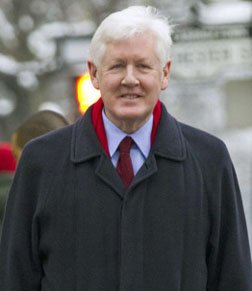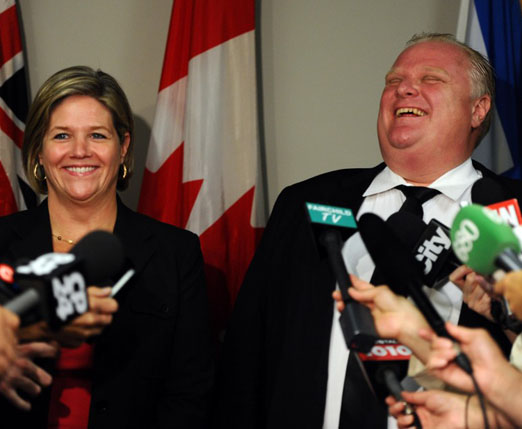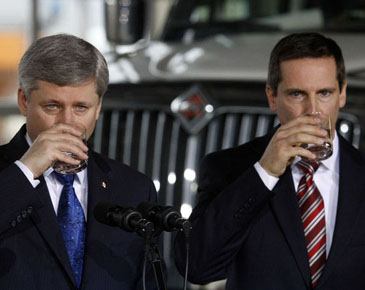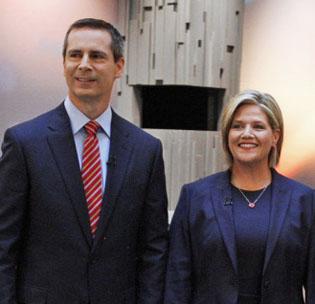Will showing the left how to co-operate be Ontario’s new role in confederation?
Jan 5th, 2012 | By Randall White | Category: Canadian ProvincesSix recent articles, mostly but not entirely from the Globe and Mail, raise some provocative prospects about Ontario’s changing role in the Canadian confederation:
“Ontario Liberals brace for a tumultuous year” (Adam Radwanski) ; “Flaherty’s corporate-tax plan hits stumbling block in Ontario” (Bill Curry) ; “Saving John McCallum’s seat will be true measure of Liberal reforms” (John Ibbitson) ; “Tory and NDP slippage gives Liberals a polling boost in key provinces” (Eric Grenier) ; “Over-hyping the Liberal convention” (Robert Silver) ; and “NDP wants cap on salaries of hospital CEOs and an end to expensive perks” (Keith Leslie).
Some would say that the new Ontario role in confederation bequeathed by the May 2, 2011 federal election is to give a parliamentary majority to a Conservative government more or less effectively headquartered in Western Canada (with special reference to the oil-rich Prairie Province of Alberta). Consider, eg., the present allocation of Conservative seats by province in the elected Canadian House of Commons: Ontario 73 ; Alberta 27 ; BC 21 ; Saskatchewan 13 ; Manitoba 11 ; New Brunswick 8 ; Quebec 5 ; Nova Scotia 4 ; Newfoundland 1 ; PEI 1.
Yet to no small extent all this just reflects the skewed political arithmetic of our first-past-the-post electoral system. The picture already starts to look somewhat different when you contemplate the May 2, 2011 Conservative popular vote by province: Alberta 66.8% ; Saskatchewan 56.3% ; Manitoba 53.5% ; BC 45.6% ; Ontario 44.4% ; New Brunswick 43.8% ; PEI 41.2% ; Nova Scotia 36.7% ; Newfoundland 28.3% ; Quebec 16.5%.
In fact, the Harper Conservatives only won a majority of the popular vote in the three Prairie Provinces of Alberta, Saskatchewan, and Manitoba. They did worst in this respect in la belle province. But even among today’s biggest anglophone provinces, the people of BC and Ontario remained somehow reluctant to go the full distance on the united right-wing wave.
Moreover, many would say, if Ontario’s definitive new role in confederation finally were to provide majority government ballast for the Harper Conservatives, then Tim Hudak’s Ontario provincial Conservatives would have won the October 6, 2011 Ontario provincial election.
Instead the Hudak Conservatives managed only 35.4% of the province-wide popular vote. The McGuinty Liberals won the largest number of seats (with 37.6% of the popular vote), but fell one seat short of a bare working majority in the Legislative Assembly.
Meanwhile, Andrea Horwath’s Ontario New Democrats won 22.7% of the popular vote. And the Ontario Liberals and New Democrats together have a decisive majority of 70 seats in the 107-seat Assembly at Queen’s Park (53 Liberals and 17 New Democrats).
* * * *
At least in theory, for the moment, all this sets Ontario provincial politics up as a potential proving ground for any strategy of Liberal-NDP co-operation (if not anything at all quite like a “merger”), as the best progressive antidote to any new Conservative/conservative dispensation that may be trying to put down roots in both federal and provincial (and even in some cases municipal) politics across Canada, coast to coast to coast.

Bob Rae in Toronto, December 30, 2011– first NDP Premier of Ontario in the first half of the 1990s, and interim leader of the Liberal Party of Canada today. Frank Gunn/The Canadian Press.
So, eg, in listing “some of the key subplots” that “Dalton McGuinty’s Liberals” are going to have to manage in the “rough-and-tumble 2012” that lies ahead, Adam Radwanski has urged that: “Sooner or later, to stay alive, the government may have to make concessions to the opposition parties –Â in particular the New Democrats, who are more inclined than the Progressive Conservatives to co-operate.”
It would seem wrong to expect anything too systematic to develop on this front too quickly. Premier McGuinty also still appears to have the somewhat different example of the Bill Davis Ontario Conservative minority governments of the later 1970s and early 1980s at the back of his mind, as at least a formal model. (And see also “Cuts coming and everyone must do their part, warns Dalton McGuinty” in today’s Toronto Star.)
Enough of the heady new hubris of the NDP official opposition in Ottawa has also seeped into Ms. Horwath’s Queen’s Park caucus to make any overt “coalition” unattractive for Ontario New Democrats, as well as Ontario Liberals.
Yet already you can see more subtle “left co-operative” forces at work in such headlines as “Flaherty’s corporate-tax plan hits stumbling block in Ontario” (partly because of revenue issues, but also partly because the NDP is against further corporate tax cuts right now).

Ontario NDP Leader Andrea Horwath visits Toronto Mayor Rob Ford and both answer questions from the media at City Hall on August 31, 2011 . VINCE TALOTTA/TORONTO STAR.
While Liberal health minister Deb Matthews has stopped short of overtly or systematically endorsing Ms. Horwath’s recent call for a “cap on salaries of hospital CEOs,” she has declared: “Certainly we do want to compensate people fairly, but I don’t think it’s fair that the average household income is around $70,000 and yet we’re paying the CEOs of our hospitals over 10 times that amount in some cases, plus all kinds of perks and benefits on top of that.”
So … what happens between the Liberals and New Democrats in Ontario provincial politics over the next 12 months could have almost as much of an impact on the progressive cause in Canadian federal politics as anything that may happen at the Liberal Party of Canada’s biennial convention in Ottawa this coming January 13—15, or even at the federal NDP leadership convention in Toronto this coming March 23—24.
And, for at least some of us, Ontario provincial politics has suddenly become interesting again – along with the NDP provincial governments in Manitoba and Nova Scotia, the changing provincial scene in Quebec, the genuinely progressive conservative new premier of Alberta, and the of course quite different juxtaposition of provincial Liberals and New Democrats in BC.



